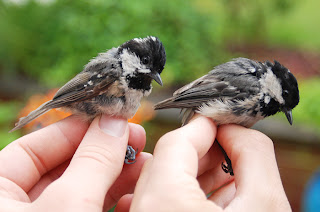Menzie seems to go for the Wood Pigeon.
Whilst Faab doesn't seem particularly happy with the Feral Pigeon..
So I guess the Wood Pigeon is our lucky winner!
Other birds ringed in the garden yesterday afternoon included a varied bunch of species. Several Goldfinches, Blue Tits, two Coal Tits, a Greenfinch, a juvenile Dunnock and the undoubtedly highlights Feral (well we didn't ring it) & Wood Pigeon.
Wood Pigeon (Columba palumbus)
Goldfinch (Carduelis carduelis), 3J in English terms
Greenfinch (Carduelis chloris), 2cy male
Dunnock (Prunella modelularis), 3J with a tasty meelworm in its mouth!
Pair of Coal Tits (Periparus ater), female left; male right
They turned out to be a nice comparison: the female (upper one) was a 2cy; note the brown alulas and primary coverts. The male (the one below) was a >2cy; dark alulas and dark primary coverts in contrast to the female. Both had started the post-breeding moult.
Yesterday we bought some wire at the shops and spend quite a few hours building a trap for in the garden; aiming for trapping the Wood Pigeons of course:) We had finished it in the evening and put it out this morning. We already have result: a Robin!
I would also like to share this photo of a Tree Sparrow (Passer montanus) pullus:
Wednesday afternoon we joined David Norman again for some pulli ringing this time. We went to a farm with Tree Sparrows. We ringeds a few broods of Tree Sparrow, a single House Sparrow brood and a single brood of Great Tits.





















